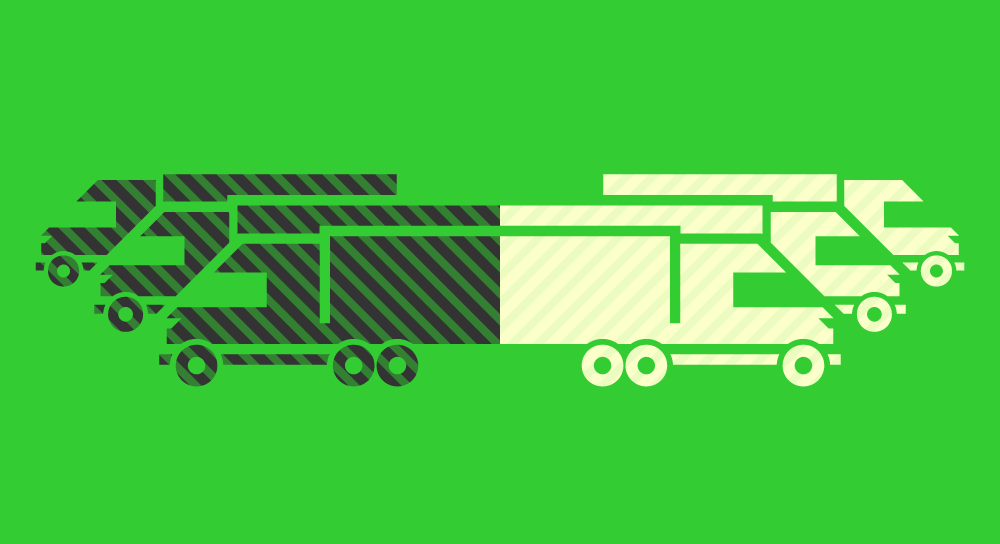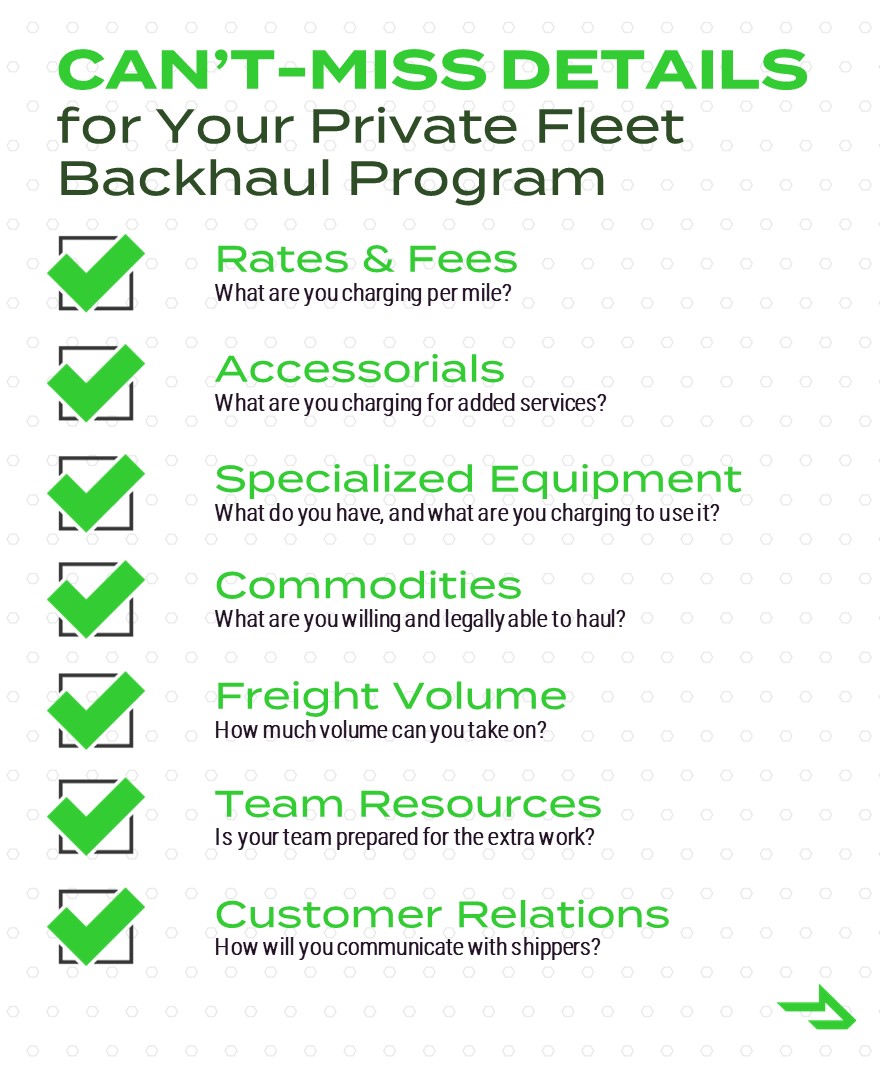Never Run Empty: How to Start a Private Fleet Backhaul Program (and Why a 3PL Should Help)
When you build your own private fleet, you’re making a long-term investment to lower your transportation costs, improve your service and increase control of your own freight.
But if your equipment is moving around empty, you’re not getting the most out of your fleet.
Good thing there’s a way to turn your fleet into a revenue generator while contributing to your corporate sustainability goals.
The solution? Starting a private fleet backhaul program.
Find out what you need to get started, how to find consistent freight when your fleet is not hauling your product and how a 3PL can really help get you program rolling.
Article Overview
- Private fleet backhaul programs defined
- Reasons why you should set one up
- What you need to run a backhaul program
- Why you should let a 3PL help
- Details to keep in mind when planning your program
What Is a Private Fleet Backhaul Program?
The first thing you need to know is what “backhauling” is — it’s when you find freight to fill a truck for its trip back to its origin or to its next destination after it makes a delivery.
Any miles driven with an empty trailer are known as “empty miles,” “dead miles” or “deadhead,” and fleet owners want to avoid this as often as they can — trucks burn fuel, valuable time and money when they are deadheading.
Some common empty mile scenarios for private fleet owners are:
- You deliver product to distribution centers, vendors and customers around the country and need to get your trucks back to your own facilities.
- You move inbound freight from a port to an inland facility; however, all of your sales volume is domestic, so you don’t have outbound product to send back to the port.
- Your fleet travels outbound from their domicile empty to pick up vendor inbound freight.
For-hire motor carriers are already used to finding freight, so seeking out backhaul opportunities isn’t unusual for them. However, it’s likely your private fleet is only accustomed to hauling your own company’s products and you don’t quite know how to identify, onboard and execute additional freight with your fleet.
A backhaul program, then, is when you put resources and processes in place to capitalize on opportunities to generate revenue by hauling other shippers’ freight in your assets. When you set one up, you’ll be able to operate your fleet as an authority for hire with backhaul moves.
It’s a way of ensuring that as few of your assets are underutilized as possible, that when your wheels are on the road, they’re likely contributing to your bottom line.
Why Should You Set Up a Backhaul Program?
There are two major reasons why private fleet owners might want to go this route.
1. Replace Empty Miles With Revenue
If you’re frequently having your fleet run empty miles, you’re wasting an incredible amount of costly resources, including both fuel and your drivers’ hours of service.
If you fill your trailer with additional freight, you’ll get paid for it. This can help defray your operational costs and protect your transportation budget.
2. Meet Sustainability Goals
Many shippers have internal or publicly stated sustainability goals, and cutting down those empty miles is a great way to work toward reducing your carbon footprint.
You’ll contribute to overall reductions in emissions by helping lower the number of trucks on the road — if a shipper is able to move their freight as your backhaul, they won’t have to find another truck to do it while yours is driving empty.
What Do You Need to Set Up a Backhaul Program?
First and foremost, you’ll need a fleet of trucks. But let’s dig a bit further into what that means in terms of:
- Ownership: You can own them outright, you can lease them or you can even set up a program using a dedicated fleet you’ve contracted from an asset carrier.
- Fleet size: You can set up a successful backhaul program with just one or two vehicles, or you can tap into a fleet of hundreds. Most programs out there use fleets at least 100-200 strong.
- Equipment: You’ll have a much easier time finding freight if your fleet features mostly 53’ trailers with swing doors. The more standard your equipment is, the more freight it can match with.
You may also need to obtain a USDOT number and/or an MC number from the Department of Transportation.
If your trucks are over 10,001 lbs. gross weight and you already haul across state lines (or intrastate in many states), you likely already have a USTDOT number.
But if your vehicles are below this weight threshold and/or you only move intrastate states that don’t require federal certification, you might not need a USDOT number for your own private fleet hauling. And you’ll need an MC number to haul freight on a for-hire basis.
If you want to haul other shippers’ freight on a for-hire basis, you will need these two numbers. The registration process entails:
- Determining whether you need a USDOT number, an MC number or both.
- An online application.
- Verification of insurance.
- Determining your state requirements.
- Completing a safety assurance program.
Why You Should Work With a 3PL to Find Backhaul Freight for Your Private Fleet
While some shippers set up internal sales teams to find freight and fill empty lanes, your best bet for getting your program rolling and keeping your trailers full is to enlist to a third-party logistics company (3PL) to find them.
3PLs can help you set up and run your program by contributing knowledge and resources that you may lack internally if you’ve only ever transported your own freight. They can:
Offload work from your internal team.
You’re likely not staffed up enough to handle running an entire third-party freight operation alongside your internal operations. 3PLs can refill this labor gap either in the short term or on an ongoing basis.
Connect you to their large shipper network.
You’ll have better luck finding freight — either ad hoc loads or consistent lanes — if you work with a provider who connects shippers to carriers every day than if you try to navigate load boards on your own.
Walk you through the set-up process.
3PLs have years of experience working with full-time for-hire carriers and with private fleet owners like you. They can make sure your documents and equipment are in order from the get-go.
Let you leverage their technology.
Logistics technology can be pricey; if you’re not willing to invest in it just yet, you can lean on your provider for web-based freight matching, customized reporting and more.
Help you understand your seasonal capacity.
If your freight volume ebbs and surges throughout the year, a 3PL can tailor your backhaul program to your fleet’s availability to avoid overwhelming you.
Consult about when and how to expand your program.
A 3PL can help you start out your program with a spot load here and there and then explore dedicated freight opportunities if and when you decide you’re ready for them.
Details to Consider When Setting Up Your Backhaul Program
Even if you’re an experienced shipper and fleet operator, there are some details you’ll need to take into account when hauling third-party freight.
Though some might seem obvious, make sure to keep all of these in mind while you get your backhaul program rolling.
Rates and Fees
What are you charging per mile? Are you staying up to date with the freight market to keep your spot and contract rates competitive? How about a fuel table?
While you need to account for the cost of operations, your equipment and driver pay, you should try to align what you charge with the prices you’re used to paying as a shipper. Treat the other shippers you work with the way you want your carriers to treat you.
Accessorials
What should you charge for detention, TONUs, loading/unloading, multiple stops, residential delivery or other accessorials?
We recommend you align your charges with what you as a shipper would pay to your carrier providers. In any event, be clear at the outset about your accessorial offerings to maximize your chances of finding a match.
Specialized Equipment
What non-standard equipment do you have and what are you going to charge shippers to use them? And are you ready to deal with them if shippers don’t want to use them?
Dunnage, pallet jacks or roller racks in your trailer might be an asset for some shippers and they’ll pay for the opportunity to use them, but others may need you to clear your trailers out completely to load them. Discuss this up front.
Commodities
What are you able to haul? What are you insured to haul? Are your drivers licensed or certified to haul hazardous materials or to enter rail yards or ports?
You’ll want to pay special attention to whether your backhaul freight might impact your equipment’s ability to haul your own freight. Many food and beverage shippers are wary of hauling anything other than food in some of their trailers, for instance.
You might also want to avoid hauling freight from competitors within your own industry.
Freight Volume
Is the volume of freight you’re willing to take on in your backhaul program sensible? Or are you biting off more than you can chew?
If you’re working with a 3PL, be very transparent about your capabilities and limitations. Don’t jeopardize your day-to-day operations by adding freight your team will struggle to handle, especially if your business has seasonal surge periods.
Team Resources
Are your operations and accounting teams prepared for the extra work a private fleet backhaul program will create?
Some fleet owners choose to staff up to accommodate a new backhaul program. Others may choose to buy instead of build and outsource this responsibility to a 3PL provider.
If you go the outsourcing route, you can likely take advantage of the online accounting processes most 3PLs offer to help easy some of the extra work.
Customer Relations
Do you know how you’re going to convey tracking data to shippers? How will you handle accounts payable? Or communication generally?
This is another place where a 3PL can really help you out — they likely offer a high level of integration which can make tracking practically hands-off after your initial set-up.
Ask Us About Strategic Capacity Solutions
Ready to set up a new private fleet backhaul program, or interested in finding freight for one you’ve already got? We’re happy to help.
We’ve been working with private fleets for more than a decade — in fact, we have an entire team dedicated to helping shippers set up and run backhaul programs. We’ve worked with fleets of all shapes and sizes, and we can be as present and invested in your success you need us to be.
We’re here to answer your questions, walk you through processes and documentation, monitor your operations, and above all else find you freight anywhere in the country in our network of 15,000+ shippers.
Simply fill out a brief form to get in touch with a private fleet specialist on our strategic capacity team.






